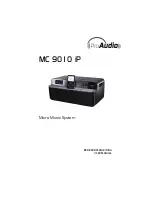
21
B1-SWM-Op-Guide-v4.pmd 030108-hto
6.3 Who Needs The FBX?
Virtually every sound system will be improved with the Sabine True Mobility
TM
Wireless System. Singers and
speakers who do not have sound technicians can now increase their monitor or house system volume so they
can hear themselves clearly and with full fidelity, without worrying if their microphone will suddenly squeal if they
move to the wrong place.
Auditoriums and churches of all sizes will enjoy reliable feedback control. Hotels and conference centers around
the world can offer meeting rooms with microphones that won’t howl during programs. The Sabine True Mobility
TM
Wireless System can be installed in theaters, schools, sports arenas, courtrooms, teleconferencing, intercoms
or interactive remote classrooms—anywhere one or multiple microphones are used.
6.4 FBX Setup & Ready Mode
The FBX Section has two modes: Setup and Ready. In Setup, the FBX filters automatically zero in on the
most predominant feedback. Because this is a wireless system, you need to move the microphone to several
areas of use during setup—this will provide maximum gain before feedback before the performance begins.
In Ready mode you are ready for the performance. Use the True Mobility as you would any wireless micro-
phone system. The FBX section will work automatically to kill any additional feedback that happens to arise.
6.4.1 FBX Fixed & Dynamic filters
Here’s how it’s done. FBX filters come in two flavors, fixed and dynamic. Both operate automatically.
Fixed FBX filters: these filters will not change frequency or depth once they are placed during Setup and the
receiver indicates Ready mode. These filters will eliminate the “first-to-feedback” frequencies encountered
during normal system operation.
Dynamic FBX filters: these filters automatically set just like Fixed filters, except they can change frequency
and depth as the need arises. Dynamic Filters stand guard if frequencies not attenuated during Setup begin
to feedback during performance.
If all filters, both Dynamic and Fixed, are in place and new feedback occurs, the Dynamic filters will move to
eliminate the new feedback. You never run out of filters!
Section Six : FBX Feedback Exterminator
It is common to describe a filter’s quality factor, or “Q,” as the center frequency of the filter divided by the filter width (in Hertz)
measured at the -3dB point. Filters that have the same Q, or width, at the -3dB point regardless of the filter’s cut or boost are called
Constant Q filters (see p.14, Figure 6a). Filters that get wider as the filter gets deeper are called Proportional Q filters (see p.14,
Figure 6b). Lately, however, the definition of Constant Q is becoming less distinct. Many equalizer manufacturers claim their
equalizers have Constant Q filters, when in fact they get substantially wider as they get deeper. The only way to know for sure
if the filters are truly Constant Q is to inspect their frequency response curves. Sabine FBX Filters are true Constant Q filters.
Constant Q vs Proportional Q Filters
Constant Q
Proportional Q
Summary of Contents for True Mobility SWM1600
Page 2: ......
















































